Jet skiing is a high-octane water sport that looks a lot lazier than it is in its modern inception.
Though many people today know the sit-and-ride version of this favorite craft as the most common type of “jet ski,” the original water jet ski was actually a stand-up model invented by Clayton Jacobson.
Jet Ski is technically the brand name for that original stand-up craft produced by Kawasaki.
Today, the generic term “jet ski” covers a wide range of personal watercraft (PWC) based off of Jacobson’s original prototype.
What is a jet ski?
A jet ski is a personal (though, the most common jet ski is designed to hold up to three people) ride-on watercraft similar in design to a motorbike or a snowmobile, but designed with a hull to float on the water.
Basically, a boatercycle.
Want to know how they function? Check out our article:
Need some specs? Check out:
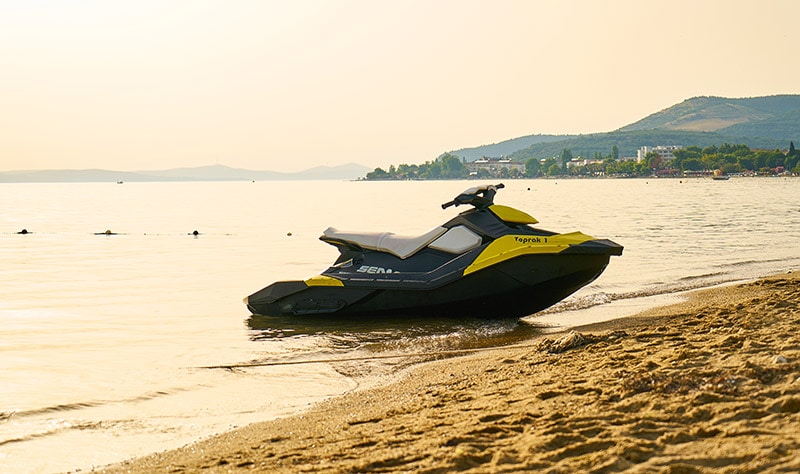
Water Jet Skiing
A jet ski may be a ride-on vehicle, but water jetskiing is more than just taking a drive.
It’s a sport much in the vein of motorbiking or horseback riding.
On a calm straight stretch, operating a jet ski doesn’t require a lot physical exertion, just a little balance, and can be fairly recreational.
Throw in some speed and hills (or rough currents), and driving a jet ski becomes a test in balance, stamina, and skill.
In fact, jetskiing at high speeds or in big waves is so similar to motorcycle sport motocross in terms of balance and muscles used that many motocross racers cross train with jet skiing and vice versa.
Though, many motocross racers choose stand-up PWC for the more strenuous workout and conditioning.
Is Jet Skiing a Workout?
Jet skiing is absolutely a sport… on a stand-up jet ski.
On a sit-down model, it’s less so, but does still require some muscle work.
From the moment you climb onto a jet ski, you need decent balance, which requires core strength.
Like most sports, the more elevated the pace and more difficult the conditions the better of exercise it becomes.
Where jetskiing becomes really good exercise is in rougher currents, when racing, when doing tricks, or when riding a stand-up jet ski.
But all of these things require more skill and pose more risks than riding a sit-down jet ski for leisure.

Jet Ski Calories Burned
When jet skiing in waves or rough currents, every muscle in the body must engage to keep you balanced and upright.
An average-size person can burn around 8 calories per minute on a standing jet ski, which is about the same calorie expenditure as swimming or jogging.
On a sit-down model, calories burned drops to around 2 calories per minute, but increases with speed, turns, waves, and body movement.
For more information on riding a jet ski, check out our articles on jet ski riding:
- Jet Ski Riding: How to Ride a Jet Ski
- Awesome Freestyle Jet Ski Tricks (For Experienced Riders)
- Flying on a Jet Ski: Three Ways To Get In The Air
Water Jet Skiing Safety
Like other recreational watercraft, jet skis (or personal watercraft/PWC) are designed to be as safe as possible for riders, but they still come with inherent risks.
Knowing what to expect when riding a PWC, how to operate it, and how to maintain it are the keys to safe riding.
Are jet skis dangerous?
Since jet skis run in the water, they seem relatively safe.
In fact, the man who invented the jet ski invented it after having a motorbike accident and wondering if there was a way to get the thrill of motorbiking without getting tossed off into rocks and solid ground.
Jet skis do, however, have their own dangers.
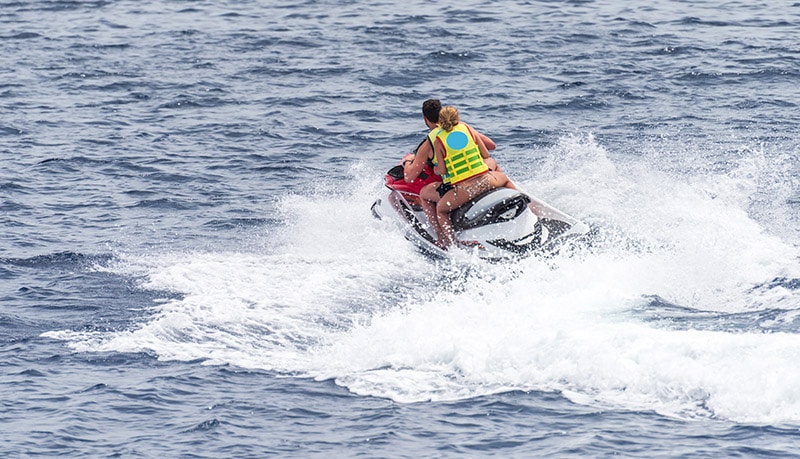
First off, you are on a machine in the middle of the water.
If you have an accident or something goes wrong with your craft, you can be stranded and face the usual dangers that come with being away from shore.
Namely, hypothermia if the craft has sunk and drowning if you’re not wearing a personal flotation device.
Second, PWCs go fast (nearing 70 mph for performance models), which is interstate speeds, without any of the same safety devices or requirements of cars.
Third, many models still don’t have brakes, which means quick stopping isn’t an option.
Fourth, jet skis require propulsion to steer, which means you can’t drop the throttle completely or you’ll have no control over the craft.
This can be hard to get used to for inexperienced riders.
Fifth, personal watercraft are engine and fuel-bearing machines. As such, they can explode.
It’s rare, but less rare than with other recreational vehicles. Jet skis require good maintenance to keep them running safely.
According to the United States Coast Guard, there are approximately 700 jet ski accidents per year with over 40 deaths.
And injuries sustained on a personal watercraft can be serious, including head injuries, broken or crushed bones, and organ damage.
To increase your safety on a jet ski, you can:
- Wear your PFD at all times, regardless of local laws
- Wear a helmet in risky conditions or where there is a lot of other water traffic
- Never exceed your craft’s weight or passenger limit
- Practice handling the craft before taking it out on busy waterways
- Pay attention to surrounding traffic and give other watercraft plenty of space
PWC Required Equipment
When it comes to safety and regulations, personal watercraft (jet skis) are considered “Class A” boats (boats under 16 feet long) by the United States Coast Guard.
As such, they are required to carry the same safety equipment as small boats.
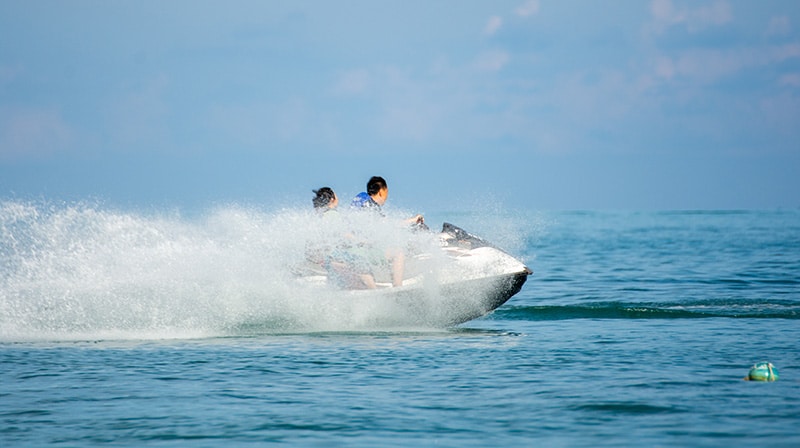
To be compliant with the U.S. Coast Guard’s safety requirements, you must have this equipment on your jet ski:
- Life jackets or personal flotation devices (PFD) for every passenger (many states require that you wear them)
- Fire extinguisher
- Visual distress signal like a flare or flag (daytime use only)
- Whistle, horn or other sound-producing device
Like most recreational vehicles and watercraft, jet skis are not completely safe, but they don’t have to be dangerous.
The vast majority of jet ski accidents are the result of poor handling, either from inexperienced or reckless riders.
You can be safe on a jet ski by taking all precautions, including wearing a PFD and helmet regardless of whether the law requires it, avoiding rough waters, and always riding cautiously.
Can a Jet Ski Sink?
Jet skis can sink, but they won’t normally sink completely, and the main cause of a jet ski sinking is, thankfully, something that is under the owner’s control.
Poor maintenance or carelessness is the main reason a Jet Ski, Sea-Doo, or WaveRunner might fill up with water and sink on its own.
Damaged or missing parts, especially seals and plugs, can cause a personal watercraft to take on water.
That’s why it’s essential to always check your PWC before climbing aboard and getting too far away from shore.
Another potential reason a jet ski might take on water is due to collision (especially with rocks) or scraping.
The best way to avoid collision is to drive a jet ski with caution and be constantly aware of surrounding obstacles (other watercraft, landscape, coral).
The best way to avoid scraping the hull of a jet ski is to avoid shallow water.
While a jet ski can float in only a few inches of water, there is always the risk of scraping against rocks, coral, or other debris in shallower depths.
If there is any good news here, it’s that when a jet ski sinks, it won’t be entirely lost.
The hulls of PWC are designed to keep them floating even if the craft fills up with water.
This makes it possible to retrieve a jet ski even if it sinks.
That doesn’t mean there won’t be some (0r even extensive) damage to the craft’s engine and drive train.
But at least you won’t lose your entire craft.
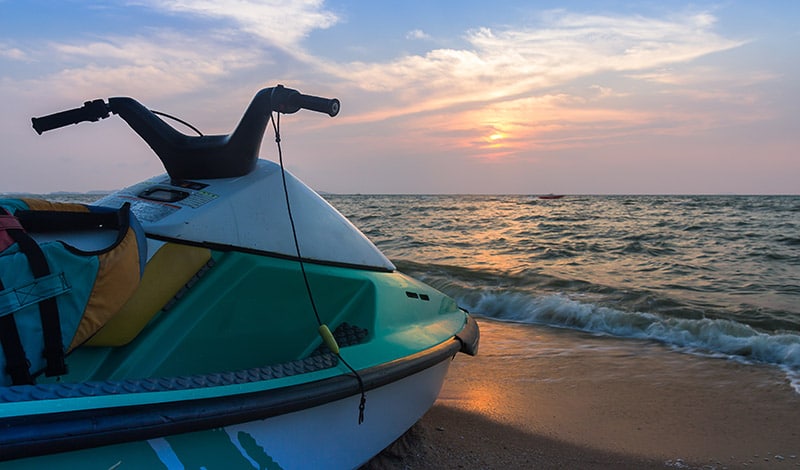
Jet Ski Laws
As previously stated , motorized personal watercraft (or jet skis) are in the same class as small boats.
This means jet ski operators are subject to the same rules and regulations small boat operators are subject to.
Typically, this includes possessing a valid boat license.
All states in the U.S. (and most countries around the world) have PWC licensure requirements or age limits for driving a jet ski.
For information on age limits by state, see our article:
Temporary Jet Ski License
So, if jet skiers are required to be licensed in most states, how is it that you see so many people renting jet skis in popular vacation spots like Hawaii, Florida, and the Great Lakes?
The answer is simple – temporary licenses.
Temporary licenses are designed for equipment renters and meant for one-time use only.
Wherever jet skis are rented, temporary, one-time use licenses are sure to be issued.
These temporary jet ski licenses require little more than a written test and legally cover riders for the purpose of operating the rental watercraft only.
Requirements, prices and restrictions for temp jet ski licenses differ from state by state.
Jet Ski Equipment
Your main piece of equipment when jet skiing is, unsurprisingly, the jet ski itself.
Jet skis come in many makes and models, but really only two main types: sit-down (the most common today) or stand-up.

Like vehicles, differences in makes and models of jet ski are typically aesthetic (they look different) or functional (they perform differently).
These articles provide information on the types of jet skis currently on the market to buy or rent:
- Jet Ski Brands (A Short History of Jet Skis)
- Sea Doo vs. Yamaha WaveRunner vs. Kawasaki Jet Ski
- Best Jet Skis (for Beginners, Families, Freestyle, and more!)
- What Is The Most Reliable Jet Ski?
Other Types of Jet Skis
Along with the two main types of jet skis (sit-down and stand-up), there are a few other jet ski options designed with specific purposes in mind.
These jet skis fall under one of the two main categories (sit-down or stand-up), but are built for greater speed, greater performance, or increased leisure on the water.
If you’re looking for a jet ski that does more than just get the job done, one of these jet ski options might be right for you.
Supercharged Jet Ski (The Fastest Jet Skis)
Looking for a PWC that goes faster than your average watercraft?
A top-of-the-line performance watercraft (and a good helmet!) is what you want.
Here’s our article on the fastest jet skis:
All three of the big three jet ski brands (Sea-Doo, Yamaha, and Kawasaki) have supercharged models designed with high-speed performance in mind.
Of these, the Kawasaki supercharged jet ski, the Jet Ski Ultra 310X or the Jet Ski Ultra 310R, is the fastest jet ski on the market.
All models in Kawasaki’s Ultra 310 line feature 4-stroke, supercharged, 310-horsepower engines and Kawasaki Smart Steering, which monitors speed and steering to help with handling.

How fast does a supercharged jet ski go?
All three speed demons from the top PWC manufacturers, the Kawasaki Jet Ski Ultra 310X (or R), the Yamaha GP1800R SVHO, and the Sea-Doo RXP-R (or X), reach speeds between 65 and 70 mph in good conditions.
Performance Jet Ski
When it comes to performance, the best model of PWC depends on what you want to do with it.
If you’re looking to race, you want top speeds and enhanced handling as in the section above.
But that kind of power requires big engines and big engines add bulk.
If you want to ride freestyle on a jet ski, throwing up flips and tricks, you’re going to want something lightweight designed for greater mobility.
That typically means a stand-up jet ski.
And this is where Kawasaki gets left in the cold.
Though Kawasaki creates a powerful stand-up, the Jet Ski SX-R, it’s weighty, coming in at a hefty 550 pounds.
As far as the big three go, Yamaha’s SuperJet, at only 375 pounds, is the far superior choice for freestyle performance on the water.
Then, there’s Krash Industries’ PWC, designed expressly for freestyle and trick-riding.
All Krash models come in at 350 pounds or under, with their pro model managing a slight, mind-boggling, and industry leading 300-pound curb weight.
Krash industries PWC are only permitted for competition in the U.S. (not for consumer use), but if you are seeking a performance jet ski trickster for competition, you’d be hard-pressed to find a lighter, more agile machine.
See more on stand-up jet skis here:
Fishing Jet Ski
Using personal watercraft for fishing is growing in popularity.
Many modern anglers see the advantages of using such small watercraft, from their fuel efficiency and speeds to their abilities to travel into tighter fishing spots.
If you’re looking for a PWC for fishing, see our article on fishing from a jet ski:
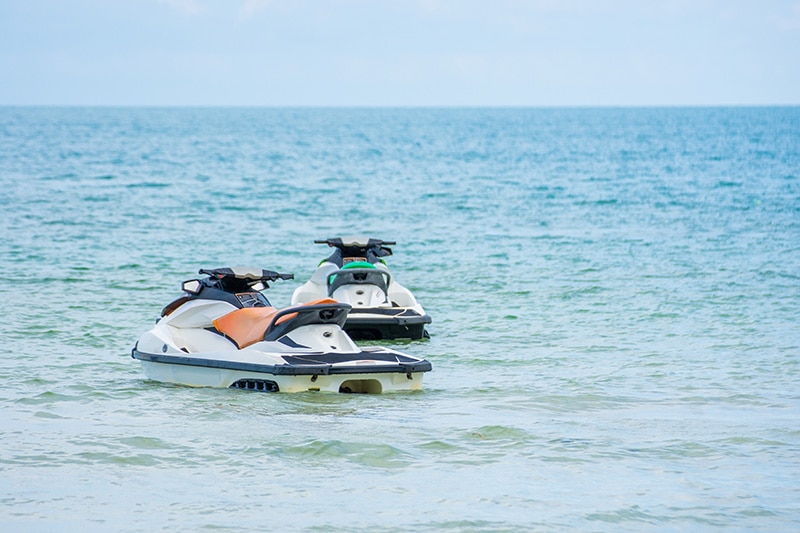
Luxury Jet Ski
Want to ride the waves in luxury? The top three PWC brands have you covered.
Kawasaki offers two luxury jet ski models.
It’s standard Jet Ski Ultra LX, designed for comfort and easy-breezy riding, or its Jet Ski Ultra 310LX, the luxury version of its most powerful craft, built for comfort AND performance.
Yamaha has a line of luxury models with comfort seats and features like increased storage or increased performance.
But it all comes together in the FX Limited SVHO, their top-of-the-line model, which combines riding comfort, a full accessory package and racing technology.
Sea-Doo’s luxury offering is the GTX Limited 300.
The ultimate lounger, the GTX Limited features a removable seat and extra cargo space, as well as an industry-leading swim platform, and is designed for all-day chilling on the water.
You can see our top pick for luxury jet ski in the Best Jet Skis (for Beginners, Families, Freestyle, and more!)
Jet Ski Accessories
While your craft may be your most important piece of equipment when it comes to riding a jet ski, there are loads of accessories available to customize and gear up your personal watercraft.
Some of these accessories are mandatory (see PWC Required Equipment above), some are extremely useful to have onboard, and some are just plain fun.
One accessory can even turn your PWC into a boat!
Check out our jet ski accessory articles to make sure you’ve got everything you need (or want) for your Jet Ski, Waverunner, or Sea-Doo.
- Jet Ski Boat: What You Should Know
- The Ultimate Jet Ski Stand Buying Guide
- Jet Ski Clothing: What To Wear Jet Skiing

Owning a Jet Ski
Personal watercraft can be a blast in the water. But, unfortunately, they don’t come cheap.
Along with your initial expenditure, which can be considerable depending on the make and model of watercraft you buy, you’ve also got license, registration, accessory, and insurance costs.
Not to mention the upkeep.
The following articles will help you determine if buying a jet ski is right for you, or if you’re better off renting at your favorite jet ski spot.
